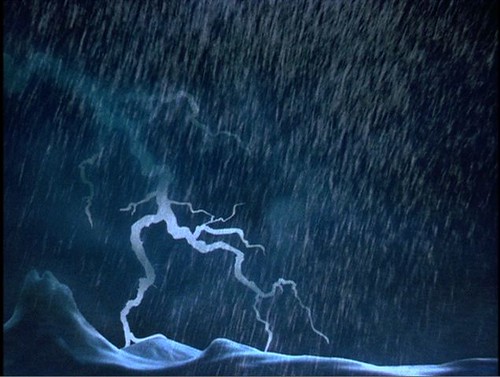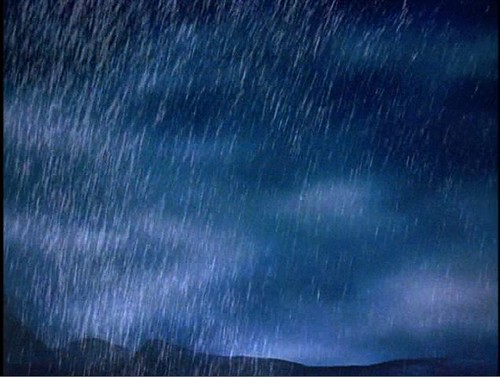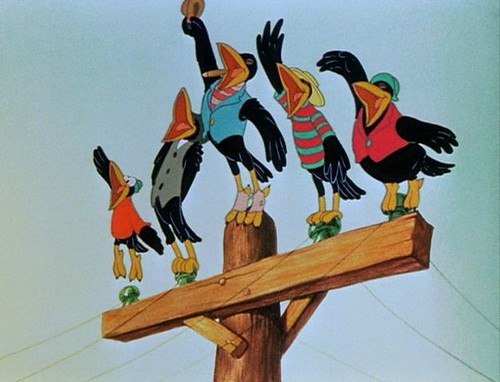What does it mean to say that Dumbo is a myth? The word has various meanings, but I mean it in the sense used by anthropologists and literary critics. In that sense myths are stories that tell members of a culture something fundamental about the world, often about how the world itself came into being, but not stated in realistic or rationalistic terms.
More often than not the members of the culture regard their myths as true, but set in Old Times when things were different. Of course, no one in Disney’s audience regarded the movie as true in that sense, not quite. Nor do I. But Dumbo does have many of the features of myths proper and it’s those features that interest me.
Why do I think this is a mythic tale? What it comes down to is that that’s the best way to account for those pink elephants on parade. While they do provide dramatic cover for a besotted Dumbo to fly up into a tree, they do much more than that, as we saw in the post, Animals in Cartoons: Tripping the Elephants Electric, where following remarks by Akira Lippit, I argued that animals show up in Golden Age cartoons as “a gesture of mourning for the disappearing wildlife” (Lippit, Electric Animal, p. 196) and machines are anthropomorphized as a way of restoring an animal presence. That equivalence between animal and machine is stated most clearly in the pink elephants episode, but it resonates throughout the film.
That gives Dumbo a mythic dimension that is not inherent in a story of mother-infant separation that otherwise drives the dramatic action. Why is that story one about an odd-ball infant? What’s the point of that? Is it simply a variation on the ugly duckling story? I think not. While Dumbo’s oddness is a personal characteristic, if you will, it also carries mythic freight, as I’ll suggest a bit later in this post.
But the scope of this post is limited. I’m not going to try to unravel the whole mythic underpinning. I just want to set things up by looking at how the movie begins and how it ends.
Out of Chaos
The film begins in a storm, with lightening, thunder, snow, sleet, hail, and rain. If you look closely near the bottom of the screen, especially during the lightening flashes, you’ll see there is a strip of land, with hills and mountains:
There’s a sententious voiceover about someone getting through all the bad weather, and then, SHAZAAM! the scene changes. The storm dissipates, to the sound of an invisible airplane, and we see naturalistic storks flying in a moonlit sky, each with a bundle hanging from its bill. The soundtrack now has a song about storks delivering, well, whatever. And then we see the earth below. The storks start heading down and dropping their bundles, which seem to have parachutes attached.
For a more detailed account of the opening, see Why a Stork? The Opening of Dumbo.
That opening establishes three regions: 1) the storm/chaos, 2) the sky (above), and 3) the earth (below). The storm makes no difference between sky and ground. Both are there, though the a viewer may miss the ground if she blinks at the wrong time. What we have, then, is chaos giving way to a division between the sky and the earth.
If we think of Dumbo as only a story about motivation, action, and character, then the point of that opening would be to emphasize the perseverance of the storks, which is the burden of the voiceover. If we think of Dumbo as myth things change. The interest in character doesn’t appear, but something else DOES appear, a typical mythic theme: chaos giving way to a differentiation between the sky and the earth.
Genesis
Consider the Judeo-Christian creation story in Genesis, which is, after all, what most of Disney’s audience would have known in some form or another. The opening line is (King James translation): “In the beginning God created the heaven and the earth.” That’s the basic distinction we’re looking at in Dumbo and it’s right there at the beginning of Genesis. Of course, there’s a bit more to the creation than that: “And the earth was without form, and void; and darkness was upon the face of the deep.” Without form and dark, that’s pretty much how that storm is. It’s not until the second day that God differentiated the sky (the “firmament” also called “Heaven” in the King James translation) from the waters, and it’s not until the third day that dry land was formed. And that’s not the end. But this process starts by asserting the distinction between heaven and earth.
Of course, the narrator in Genesis explicitly asserts that the world is being created and that it is God Who is doing it. Dumbo isn’t like that. There is no assertion that the world is being created, much less that God is at work. But the on-screen imagery presents certain things in a certain order. Those things and their order roughly follow the what happens in the opening verses of Genesis: First, undifferentiated chaos in the form of a storm. Second, we see the sky (and the storks). Third, we see the ground below.
Now, in making this comparison I’m not trying to argue that Disney’s team had Genesis in mind at the beginning of Dumbo. I’m not even arguing that Genesis was lurking down there in the subconscious, though perhaps it was. The argument I’m making is even stranger, and more difficult to conceptualize. I’m arguing that the ancient tellers of Genesis and the modern creators of Dumbo had similar problems to solve and they produced solutions that had similar terms.
The tellers of the Genesis myth—for I’m assuming that the story existed in oral tradition before it was written down—wanted to explain where the earth came from. The tellers of Dumbo wanted to explain where the modern world came from, though not historically. Not only is that a complicated story, as history usually is, it’s not the right KIND of story. History just tells who did what when and where. But the modern world is strange; it contains things quite different from the 19th century world, like airplanes. Where did those things come from IN THE NATURE OF THINGS?
That’s why we have those storks. They provide a folkish answer to the question: Where do babies come from? And that question is a deep and mysterious one. Parents may tell that tale to children because they don’t, for whatever reason, want to tell them about sex. But even if they did tell the truth, what would that get them? More questions is what, more questions. Now they have to explain how a male seed, sperm, and a female seed, an ovum, somehow mix and become this thing called a zygote, and this zygote divides—how does it do that?—and divides and divides and becomes a baby. Does that explain anything? Not really. It just provides a platform for more questions that don’t have good answers.
Thus, we have this film that starts in a way that echoes origin myths and quickly presents us with an origin fairy tale in the form of a kid-friendly story about babies. The opening of this film has MYSTERY OF ORIGINS stamped all over it. But, so goes my argument, the mystery isn’t about Dumbo. We know where he came from; he was delivered by a stork. But what about those ears? The stork story doesn’t tell us anything about them. Nor does the movie. It tells us nothing about where they came from. But, it DOES use them in an interesting way.
Now we’re getting ahead of ourselves. Let’s return to the beginning of them. We have the storm, and out of it we have those storks. The storks are creatures of the sky, but their bundles contain creatures of the earth, as we soon find out.
Oppositions
That is to say, in the structuralist language used by the late Claude Lévi-Strauss, we have an opposition between the sky and the earth. Now, of course, oppositions are common in stories. But it’s one thing to talk of, say, an opposition between good and bad. We can put Dumbo, his mother, Timothy Mouse, and the crows on the side of good and the ringmaster, the clowns, the matron elephants and the pesky boy on the side of bad, or something close to it. That opposition would seem to be driving the plot of the movie.
But an opposition between the sky and the earth, that’s a bit different. That would seem to be rather more incidental to the story. And by itself, perhaps it is. What we have to do is consider it in relation other elements in the story.
Storks are creatures of the sky. They’re birds. So are crows. But lions, tigers, bears, camels, and other animals are creatures of the earth, as are elephants. What is Dumbo? He’s an elephant, and so a creature of the earth, no? Well, yes. But it turns out that he’s also a creature of the sky, like the storks and the crows. That is, something about Dumbo goes against the essential nature of earth creatures, such as elephants.
If creatures must be either of the sky or of the earth, then Dumbo doesn’t fit. He’s an anomaly. Yes, birds do walk on the earth, and some of them swim as well, but it’s their ability to fly that makes them distinctive. At least in myth logic, and that’s what we’re talking about, myth logic. A flying elephant, that just doesn’t make any sense, which is the central point of the song sung by the crows, who are birds good and proper—except that they wear clothes.
And that IS Dumbo’s problem from the beginning, isn’t it, that he doesn’t fit in? But his anomalous status is not presented as being able to fly. It’s presented as a cosmetic issue: he’s got big ears. That’s why he’s ridiculed. The discovery that he can fly in fact provides him a way of fitting in.
At this point it looks like I’ve talked myself out of the argument I was setting up. On the one hand, Dumbo is anomalous because he’s a creature of the land that somehow is able to fly. On the other hand, being able to fly is what gives him, not only a place in the circus, but a unique and favored place. The characteristic that makes him an anomaly also resolves his anomalous status. That’s like saying black is white, or A = not-A. That just doesn’t make any sense.
But it does. In myth logic.
Buy I’m not going to untangle it in this post. I just want to set up the problem.
Into the Sunset
With that in mind, let’s skip over just about everything that happens in the film and take a look at the end–the very end, after Dumbo’s landed safely in his mother’s lap—and Timothy Mouse is nowhere to be seen— while she’s sitting in the modern aerodynamically-styled private car his success has brought them. As we watch the train heading off screen to the left the camera zooms to the crows standing on a telephone pole and then follows the train into the sunset as the crows chatter away on the soundtrack:
The end is the opposite of the beginning, and in many ways. Of course the plot has been resolved, but at the very beginning, when we first saw the storks in the sky and the earth below, we hardly even knew what the plot was about. But even without knowing anything about the plot we can see that imagery is opposite. The film started at night, and in a storm. It ends during the day and in clear weather. That difference is not dictated by the plot in any strong way. As far as plot requirements are concerned it would have been just as easy to have Dumbo and his mother marching triumphantly into the ring, ready to perform.
Ending the movie on crow chatter over a train ride into the sunset is “merely” an aesthetic choice. But it plays into myth logic, as the difference between night and day is important to the film’s rhythm. The film opens in a stormy night (day one), the tent is erected during a stormy night (day two), Mrs. Jumbo is jailed during a night (day three), Dumbo is banished during a night-time meeting (day four), and, of course, Dumbo and Timothy Mouse see pink elephants during the night (day five). It’s during the intervening days that circus acts go awry and plans are thwarted. Again, that’s not dictated by plot requirements in any strong way, but represents aesthetic choice, choice that follows the logic of mythic oppositions.
For a quick look at the night/day division, see Dumbo: Six Nights, Six Days.
The storks are the first living creatures that we see, and we see them flying in the sky. The crows are the last living creatures we see. While they are creatures of the air, like the storks, they’re not flying and they’re not in the sky. But they’re not exactly on the ground either. They’re on a telephone pole. The pole is dug into the ground, but the crows themselves are up off the ground.
And they’re wearing clothes, while the storks at the opening were not. Further, those storks were naturalistically styled while these crows are not. Those opening storks did not talk, while the crows are most talkative.
[Note that the stork who delivered Dumbo is, in these terms, more like the crows. He’s clothed, talks, and cartoonistically styled.]
Now, let’s look back into the film a bit. Where were the crows when we first saw them? They were up in a tree. And a telephone pole is something like a man-made tree. It’s dug into the earth, and it has “branches” at the top. It’s also high tech.
The opposition between the sky and the earth on a stormy night has been reduced to and transformed into an opposition between the top and the bottom of a telephone pole on a sunny day. The crows are at the top and the train tracks are at the bottom. And, as we’ve seen, a whole lot more is tied up in that transformation from sky vs. earth to telephone pole vs. train tracks.
What Next?
Where I’m going with this argument is that Dumbo is Disney’s myth of modernity. Modernity is many things; in this film it’s machines, electricity, and mobility—home, for Dumbo, moves about from place to place. How do we fit those very modern, very artificial things, into the more “natural” world scheme of small-town 19th Century America? That’s Disney’s problem. It’s not a problem about history. It’s about myth and symbolism.
Dumbo, and his pink elephants, solves part of Disney’s problem by providing a way of assimilating machines and electricity to the animal world. Just how Disney does this, and why it works in terms of myth logic, that’s what I’m after. I may get to in the next post, or the one after that. I don’t know what it’ll take. We’ll just have to wait and see.




No comments:
Post a Comment